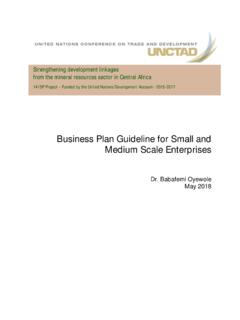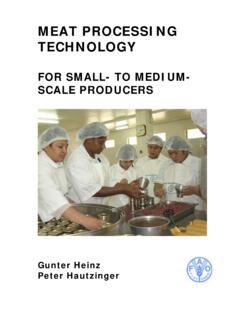Transcription of Energy Intensive Industries (EIIS) - GOV.UK
1 July 2022 (revised) Energy Intensive Industries (EIIS) Guidance for applicants seeking a certificate for an exemption from the indirect costs of funding Contracts for Difference (CFD), the Renewables Obligation (RO) and the small - scale Feed in Tariff (FIT) Crown copyright 2022 This publication is licensed under the terms of the Open Government Licence except where otherwise stated. To view this licence, visit or write to the Information Policy Team, The National Archives, Kew, London TW9 4DU, or email: Where we have identified any third-party copyright information you will need to obtain permission from the copyright holders concerned. Any enquiries regarding this publication should be sent to us at: 3 Contents Introduction _____ 4 Eligibility _____ 5 The Sector Level Test _____ 5 The Business Level Test _____ 6 Force Majeure _____ 7 Undertakings in difficulty _____ 7 Calculating the level of the exemption _____ 10 Businesses that make several products _____ 10 Businesses that have restructured _____ 10 Meter and network sharing _____ 11 Third Party arrangements _____ 11 Applying for the exemption _____ 12 Information required _____ 12 Issuing certificates _____ 12 Appeals _____ 13 Supporting evidence needed from applicants _____ 14 Monitoring and verification _____ 15 Quarterly reports _____ 15 Re-application _____ 15 Monitoring _____ 15 Information sharing, publication and transparency _____ 16 Change of details or circumstances _____ 17 Recovery of money from over-exempted Energy Intensive Industries _____ 17 Appendix.
2 Example Calculations _____ 19 The 20% Business Level Eligibility Calculation _____ 19 Proportion of Electricity Eligible per Meter _____ 21 Worked Example _____ 21 Annex 1: Eligible activities _____ 23 Annex 2: Information required from applicants: checklist _____ 26 Applying for a certificate for an exemption from the indirect costs of funding CFD, RO and FIT 4 Introduction 1. The UK government is committed to achieving net zero greenhouse gas emissions by 2050. This requires a transformation of the UK economy, including the Energy market, while keeping Energy costs down for business and consumers, and maintaining competitiveness. 2. Several policies have been developed to increase the share of electricity generated from renewable and low carbon sources. Specifically, the government has put in place the Contracts for Difference (CFD) and Renewables Obligation (RO) schemes and the small - scale Feed-In-Tariff (FIT), amongst others, to incentivise low carbon and renewable electricity deployment.
3 The costs of funding these schemes are recovered through levies or an obligation on suppliers and these are ultimately passed on to domestic and non-domestic electricity consumers bills. 3. The government recognises that, in the short to medium term, the resulting increase in retail electricity prices may risk putting certain electricity- Intensive businesses at a significant competitive disadvantage when they are operating in international markets. To address this risk, the government has developed exemption and compensation schemes. These schemes have been approved by the European Commission as compatible State aid and are compatible with the new UK Subsidy Control regime. The exemption schemes have been implemented by secondary legislation1 approved by Parliament. (The legislation implementing the CFD exemption, the Electricity Supplier Obligations (Amendment & Excluded Electricity) Regulations 2015, as amended, is hereafter referred to as the Regulations.)
4 The purpose of this guidance document is to explain how eligible businesses can apply for the CFD, RO and FIT exemption schemes. The eligibility criteria and process of assessment are the same for all these exemption schemes. 4. The CFD, RO and FIT exemption schemes do not apply to Northern Ireland. Companies based solely in Northern Ireland can currently apply for RO compensation and should refer to the Compensation Scheme Guidance. Companies with sites in both Great Britain and Northern Ireland should use this guidance. 1 Applying for a certificate for an exemption from the indirect costs of funding CFD, RO and FIT 5 Eligibility 5. There are five key requirements in determining whether a business is eligible for an EII certificate for an exemption from a proportion of the indirect costs of funding the CFD, RO and FIT: The business must manufacture a product in the UK within an eligible sector (defined by a 4-digit NACE Code) the sector level test.
5 The business must pass a 20% electricity intensity test the business level test . The business must not be an Ailing or Insolvent Economic Actor (AIEA) (see paragraphs 24-29 below). The business must have at least two quarters of financial data. The application must contain evidence of the proportion of electricity used to manufacture the product for a period of at least three months. 6. In this guidance, business (or the applicant ) refers to the legal entity manufacturing a product in the UK within an eligible NACE Code, such as a Company registered at Companies House. 7. If an agent is applying for an exemption on behalf of a client, they must submit a Letter of Authority (LoA) with the completed application which confirms they are acting on behalf of the applicant for this purpose. This should be signed by a Director or a senior manager within the business. 8. A business that successfully applies for the exemption will be issued with a certificate (an EII certificate ) confirming their eligibility for the CFD, RO and FIT exemption.
6 9. Successful applicants should then pass their certificate on to their electricity supplier so that they receive the benefit of the exemption. Please note that electricity suppliers will need to set up the relevant arrangements before they receive, and therefore pass on, the exemptions. The Sector Level Test 10. The European Commission s Guidelines on State aid for environmental protection and Energy 2014-20202 (referred to in this guidance as the EEAG) s ets out which sectors (by 4-digit NACE code) could be eligible for exemption. 11. To ensure that support is targeted at those most at risk, the UK Government further limited eligibility to those sectors which are electricity Intensive and subject to international competitive pressures using UK specific data from the Annual Business Survey, specifically, those found to have a trade intensity of at least 4% and an electricity-intensity of at least 7%.
7 Eligible sectors are those carrying out the activities listed in Annex 1, referred to as specified activities in the Regulations. 2 (01) Applying for a certificate for an exemption from the indirect costs of funding CFD, RO and FIT 6 12. Applicants will need to establish that they manufacture a product(s) in the UK that falls within one or more of the eligible 4-digit NACE codes in Annex 1. If a business does not manufacture a product in one of these sectors it will not be eligible for an EII certificate. Businesses that produce both eligible and ineligible products can apply but the exemption can only be applied to the proportion of electricity used to produce the eligible product. The Business Level Test 13. The purpose of the business level test is to ensure that the exemptions target only those businesses where support is most needed, those that will be put at a significant competitive disadvantage from the costs of funding renewable and low carbon policies.
8 14. To satisfy the business level test, businesses will need to show that their electricity costs amount to 20% or more of their Gross Value Added (GVA) over a reference period the relevant period . 15. GVA is defined as earnings before taxes, interest, depreciation and amortisation (EBITDA) excluding items which are extraordinary and all staff costs including employers pension and national insurance contributions, director s salaries and bonuses, casual or agency staff costs and other arrangements where employees are paid indirectly. 16. In line with the Financial Reporting Standard applicable in the UK and Republic of Ireland (FRS 102), which provides general accounting procedures on extraordinary expenditure, we define an extraordinary item as something which is highly unusual or infrequent in nature and not related to the ordinary and typical operating activities of the business. 17. If a business has a subsidiary business, they can apply at any level provided the applicant is a legal entity such as a Company registered at Companies House.
9 18. Eligibility will be assessed using data based on the applicant s financial year. If applicable, the accounts on which data has been based must have been submitted to Companies House to allow verification. A business cannot apply with fewer periods of data than exist it is not permissible to exclude a year to ensure eligibility. The relevant period for businesses is as follows: For businesses with three or more years of published annual accounts, the relevant period will be the three most recent consecutive years for which there are annual accounts. For businesses with two years of published annual accounts, the relevant period will be those two years. For businesses with one year of published annual accounts, the relevant period will be that one year. A business that does not have any annual accounts and has been trading for 21 months or less can also apply. The relevant period in this circumstance will be the period for which they have been carrying out a specified activity and have financial data in the 12 months prior to making an application (which must be at least six months).
10 Such businesses will need to supply a copy of their first set of annual accounts to BEIS within 30 days of the accounts being finalised. Applying for a certificate for an exemption from the indirect costs of funding CFD, RO and FIT 7 Businesses with fewer than two financial quarters of financial data are ineligible. For businesses with unusual accounting periods ( which are longer or short than a 12-month period), we will use the period used in the published accounts. 19. Businesses will need to re-apply each time their EII certificate expires (which will generally be annually see paragraphs 47-51 for more information about when certificates expire). However, the eligibility of businesses with three or more years of annual accounts will only be reviewed when an application is made for their 6th EII certificate ( they can receive four more certificates after their initial application before their eligibility will be reassessed).














